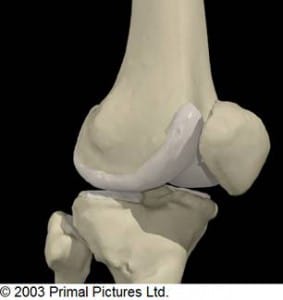PATELLAFEMORAL PAIN SYNDROME
The patella (knee cap) is essentially a floating bone. It transfers the force of the largest and strongest muscle grouping, the quadriceps (front of thigh), into the lower leg. The quadricep muscles are utilised in movements involving straightening the leg, such as getting out of a chair and going upstairs. They also play a vital role in controlling the rate at which the knee is bent, which allows us to perform smooth and controlled movements, such as going down stairs and sitting down without collapsing.

The patella has the thickest cartilage in the body underneath, which allows it to glide with less friction. This is very important, as it not only moves up and down, but is compressed in a groove called the trochlear notch between the femoral condlyes (bony enlargements on the end of the thigh bone). This groove helps prevent the patella slipping sideways and dislocating when performing twists and turns with the knee bent and helps to improve the angle of pull of the quadricep muscles.
The patella also relies on the muscle tendons and ligaments attached to guide through the optimum position in the groove. If it drifts out of position, the high forces it has to deal with are not transmitted evenly and the cartilage tends to wear thin where the compression and friction is greatest.
The cartilage itself is not pain-sensitive, but the underlying bone is and it’s this which is believed to produce a general discomfort.
It’s unsurprising that this is felt most when the knee is bent, as the patella is pulled tighter into the grove. Patients will often feel the urge to straighten the knee when sitting for prolonged periods, such as in cinema. Hence, this complaint is also referred to as “movie-goer’s knee”. Repetitive loading of a bent knee can exacerbate this further, such as going up and down stairs. Patients are not always aware of immediate discomfort – it can be after the activity or even the following day.
This type of injury can occur when a marathon runner is stepping up their mileage. The patella alignment may have been an issue for years, but the repetition of running can bring on patients’ symptoms which makes them aware of it.
The most common causes for this include:
• Localised muscle weakness, often medial muscles, e.g. vastus medialis obliqus (VMO).
• Tight lateral joint structures, e.g. iliotibial band (ITB).
• Aberrant foot mechanics, such as hyper-pronation (flat feet).
• Poor footwear, e.g. poor arch support/heel cup.
• Poor hip and pelvic stability, e.g. gluteus medius weakness.
• Physical anomaly, such a hip retroversion, and increased q-angle.
• Over-training.
(The list of conditions given above and subsequent explanations are intended as a general guide and should not be considered a replacement for a full medical examination. Furthermore, we do not purport to treat all the conditions listed. Should you wish to discuss any of these conditions with our chiropractors, please do not hesitate to phone the clinic on 020 7374 2272 or email enquiries@body-motion.co.uk).
Our team of chiropractors and massage therapists are on hand to answer any questions you may have, so get in touch today via enquiries@body-motion.co.uk or on +44 (0)20 7374 2272.
